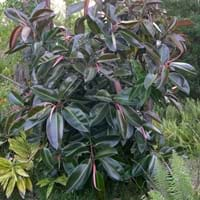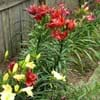Life Span
Perennial
Perennial
Type
Bulb or Corm or Tuber
Tree
Origin
North America, Europe, Africa, Asia
Southern Asia, Southeastern Asia, India, Nepal
Types
White lily, orange lily, Lily of the valley
not available
Habitat
Not Available
agricultural areas, Along Railroads, Coastal Regions, Forests, Roadsides, Scrubs, Suburban areas
USDA Hardiness Zone
2-8
10-11
Sunset Zone
21,22
H1, H2, 16, 17, 19, 20, 21, 22, 23, 24
Habit
Upright/Erect
Upright/Erect
Flower Color
White, Yellow, Red, Green, Purple, Gold, Pink, Rose, Peach, Burgundy, Bronze
Not Available
Flower Color Modifier
Bicolor
Bicolor
Fruit Color
Yellow green, Sandy Brown
Yellow, Yellow green
Leaf Color in Spring
Green, Dark Green
Red, Dark Green, Crimson
Leaf Color in Summer
Light Green
Red, Dark Green, Crimson
Leaf Color in Fall
Several shades of Green
Red, Dark Green, Crimson
Leaf Color in Winter
Light Green
Red, Dark Green, Crimson
Leaf Shape
Long Linear
Elliptic to oblong
Plant Season
Spring, Summer, Fall
Spring, Summer, Fall, Winter
Sunlight
Full Sun, Partial Sun, Partial shade
Full Sun, Partial Sun, Partial shade
Type of Soil
Clay, Loam, Sand
Loam, Sand
The pH of Soil
Acidic, Neutral, Alkaline
Acidic, Neutral, Alkaline
Soil Drainage
Well drained
Well drained
Bloom Time
Not Available
Not Available
Tolerances
Drought
Not Available
Where to Plant?
Container, Ground, Pot
Ground
How to Plant?
Seedlings
Seedlings, Vegetative Reproduction
Plant Maintenance
Medium
Medium
Watering Requirements
Do Not over Water
Keep ground moist, Requires a lot of watering
In Summer
Lots of watering
Lots of watering
In Spring
Moderate
Moderate
In Winter
Average Water
Average Water
Soil pH
Acidic, Neutral, Alkaline
Acidic, Neutral, Alkaline
Soil Type
Clay, Loam, Sand
Loam, Sand
Soil Drainage Capacity
Well drained
Well drained
Sun Exposure
Full Sun, Partial Sun, Partial shade
Full Sun, Partial Sun, Partial shade
Pruning
Prune in early spring, Prune in fall, Remove dead or diseased plant parts
Prune for shortening long shoots
Fertilizers
All-Purpose Liquid Fertilizer, Fertilize only when soil is poor
don't fertilize in winter
Pests and Diseases
Lily Beetle
Mealybugs, Red blotch, Scale, Spider mites, Yellow Leaves
Plant Tolerance
Drought
Not Available
Flowers
Showy
Insignificant
Flower Petal Number
Single
Not Available
Foliage Texture
Not Available
Bold
Foliage Sheen
Not Available
Glossy
Attracts
Not Available
Not Available
Allergy
Not Available
Asthma, breathing problems
Aesthetic Uses
Beautification, Showy Purposes
Showy Purposes
Beauty Benefits
Making cosmetics
Not Available
Environmental Uses
Not Available
Air purification, soil erosion prevension on hill slopes
Medicinal Uses
Burns, Diuretic, Heart problems
Not Available
Part of Plant Used
Whole plant
Latex
Other Uses
Cosmetics, Oil is used for aromatherapy, Used As Food, Used as Ornamental plant, Used for its medicinal properties
Making rubber, Making tyres
Used As Indoor Plant
Yes
Yes
Used As Outdoor Plant
Yes
Yes
Garden Design
Alpine, Container, Cutflower, Feature Plant, Mixed Border, Wildflower
Container, Feature Plant, Houseplant, Shade Trees, Tropical
Botanical Name
LILIUM
FICUS elastica
Common Name
Lily
Rubber Plant
In Hindi
लिली
रबड़ का पौधा
In German
Lilie
Ficus elastica
In French
Lis
Ficus elastica
In Greek
Κρίνος
ελαστικός φίκος
In Portuguese
Lírio
fábrica de borracha
In Polish
Lilia
gumy roślin
In Latin
lilium
Flexilis herba
Phylum
Tracheobionta
Tracheophyta
Class
Liliopsida
Magnoliopsida
Family
Liliaceae
Moraceae
Clade
Angiosperms, Monocots
Angiosperms, Eudicots, Rosids
Subfamily
Lilioideae
Not Available
Number of Species
Not Available
Importance of Lily and Ficus Elastica
Want to have the most appropriate plant for your garden? You might want to know the importance of Lily and Ficus Elastica. Basically, these two plants vary in many aspects. Compare Lily and Ficus Elastica as they differ in many characteristics such as their life, care, benefits, facts, etc. Every gardener must at least have the slightest clue about the plants he wants to plant in his garden. Compare their benefits, which differ in many ways like facts and uses. The medicinal use of Lily is Burns, Diuretic and Heart problems whereas of Ficus Elastica is Not Available. Lily has beauty benefits as follows: Making cosmetics while Ficus Elastica has beauty benefits as follows: Making cosmetics.
Compare Facts of Lily vs Ficus Elastica
How to choose the best garden plant for your garden depending upon its facts? Here garden plant comparison will help you to solve this query. Compare the facts of Lily vs Ficus Elastica and know which one to choose. As garden plants have benefits and other uses, allergy is also a major drawback of plants for some people. Allergic reactions of Lily are Not Available whereas of Ficus Elastica have Asthma and breathing problems respectively. Having a fruit bearing plant in your garden can be a plus point of your garden. Lily has no showy fruits and Ficus Elastica has no showy fruits. Also Lily is not flowering and Ficus Elastica is not flowering . You can compare Lily and Ficus Elastica facts and facts of other plants too.





